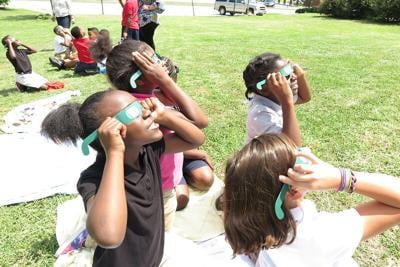Time to dust off those eclipse-viewing glasses from seven years ago.
For the first time since 2017 and for the last time until 2045, a partial solar eclipse will be visible in Milledgeville Monday.
The celestial event will begin at 1:45 p.m. local time as the moon’s orbit places it between Earth and the sun, causing what will look like a shadow to pass over the sun over the course of two and a half hours. The maximum eclipse is set to occur around 3:05 p.m. locally when nearly 80% of the sun will be covered, causing the day to be darkened in a somewhat eerie fashion.
Weather plays a big factor in eclipse viewing since experiencing one while skies are cloudy is a lot less thrilling. According to the National Weather Service though, Monday’s forecast is mostly sunny with only about 22% of sky expected to be covered by clouds during the eclipse window in Milledgeville.
The last solar eclipse seen in Milledgeville happened in August 2017 when 97% of sunlight was blotted out. The higher number seven years ago was due to Milledgeville’s proximity to what’s known as the “path of totality,” which passed through northeast Georgia. Areas within that narrow path see full coverage often for a couple of minutes’ time while areas outside the path experience less coverage to varying degrees. This year’s path of totality enters the United States in Texas and will travel northeast before leaving the country in Maine.
Scientists within the realm of astronomy and physics, like Georgia College & State University lecturer Dr. Shahram Talei, see eclipses as opportunities to educate the public on their fields of study.
“A lot of us are very excited,” Talei said.
Many people across the country will travel to cities and states where they can see the total eclipse since the opportunity only presents itself maybe a few times in one’s life. There’s special reason to road trip for this year’s eclipse.
“This one is a little more exciting than 2017 because in this case the moon is closer, so for places that will experience the total eclipse, it will be two minutes longer than in 2017,” Talei said for those areas within the path of totality. “Typical time for solar eclipses is around two minutes. For this one there’s a maximum of four minutes.”
The moon’s closeness to the Earth isn’t all that makes the upcoming eclipse more exciting.
“This year we also have higher solar activity. While the solar eclipse is happening, that’s a good opportunity for a lot of people to study solar flares and what’s going on around the sun since it’s covered during the eclipse. In this case because we’re in a maximum solar activity year, a lot of people are looking forward to this opportunity because the sun is more active than usual,” Talei said, adding that solar activity fluctuates on an 11-year cycle.
Talei will be among the GCSU professors on campus with tables set up outside the Arts & Sciences building from 2 to 4 p.m. Monday. There they will have “solarscopes” on hand to capture the eclipse in a different way. Rather than operating like a telescope to look towards the sky, the solarscopes capture the sun’s light and project it downward onto a piece of paper. The moon will appear as a shadow, allowing viewers to track its movement during the eclipse period. This method is not harmful to the eyes and requires no additional protection. For those opting to look up, protective eyewear is a necessity because damage from looking directly at the sun can occur in a matter of seconds. The only people who can look directly at the eclipse without protection are those in the path of totality for those four minutes or so that totality occurs. Everyone else watching, including those in Milledgeville, need special eclipse-viewing glasses in order to look up. Regular sunglasses won’t do, NASA says on its website. Mary Vinson Memorial Library has free eclipse glasses available to the public while supplies last.
The next solar eclipse visible in Georgia will happen over two decades from now in the year 2045. Sun coverage in Milledgeville will be more akin to the 2017 event as the path of totality will pass through the state’s southwest corner before heading down into Florida.











